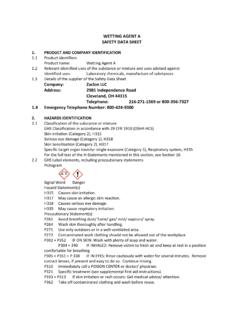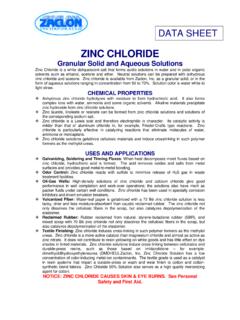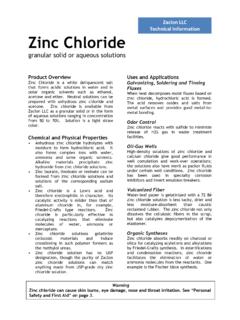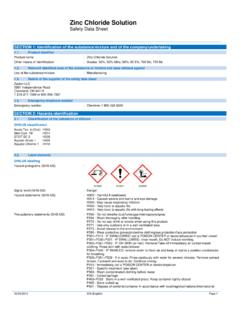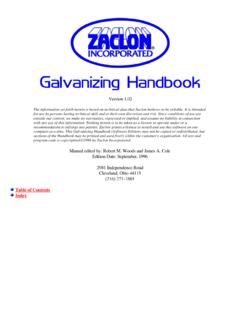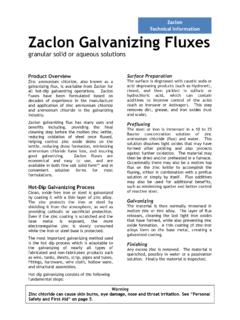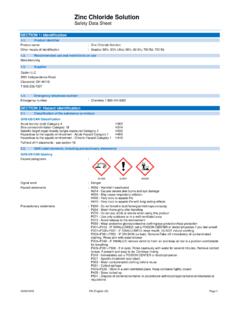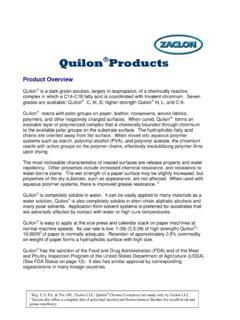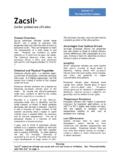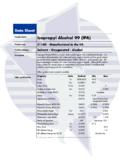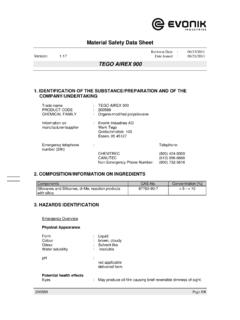Transcription of Technical Information Volan - ZACLON
1 ZACLON LLC. Technical Information Volan . bonding agent Coupling Agent and Adhesion Promoter for Composites CH2. C CH3. C. O O Chemical and Physical Properties Cl Cl Physical properties and typical analyses are Cr Cr shown in Tables 1 and 2. Cl Cl O Table 1. Physical Properties Volan . H. Appearance Dark Green Cr (III) Methacrylate Surface Active Agent Odor Alcoholic Boiling Point, oC (oF) 79 (174). Product Overview Flash Point Volan adhesion promoter is a specialty (Tag Open Cup), oC (oF) 6 (43). formulated solution containing unique Specific Gravity at surface-complexing monomers of Chromium 20oC (68oF) (approx.) (III) Methacrylate. During application, the pH of 1% H2O Solution active molecules attach to inorganic or polar substrates and orient themselves with Table 2. polymerizable groups outward permitting Typical Analyses Volan . reaction with a wide variety of thermosetting resins such as: Chrome Complex, % 19-21. Polyesters (active ingredient).
2 % Chromium Epoxies % Chloride Phenolics % Methacrylic acid Vinyls Acrylics Solvent Carrier, % 79-81. % Isopropanol 40. The ability of Volan to react to inorganic or % Acetone 10. polar surfaces provides enhanced adhesion to % Water 30. many substrates such as: Glass Note: Tables 1 and 2 give typical properties based on historical production performance. Fiberglass ZACLON does not make any expressed or Engineering or Carbon fibers implied warranty that this product will Silica continue to have these typical properties. Metals Warning Volan can cause eye burns and skin, nose, and throat irritation. Volan is also a flammable liquid. See Personal Safety and First Aid on page 4. Volan is completely miscible with water and coating on silica microspheres. The presence its performance is not affected by normal of a Volan coating increases the bonding of water hardness. However, hard or otherwise the microspheres or filler to the polymer contaminated water is always suspect if the substrate, and also gives easy-flowing treating solution is not clear or if handling characteristics.
3 Neutralization by the recommended procedures results in precipitation of the Finish for Glass Fabric Reinforcement complex. Volan is usually applied to glass fabric by a treating and washing step known throughout Volan bonding agent begins to polymerize the industry as the A finish. This finish was when it is diluted with water and if alkali is qualified under military specification MIL-F- added. It is the partly polymerized complex 9118A. that permits effective bonding between a resin and a hydroxylic surface. The diluted Typical laminate performance of the A . Volan should be neutralized to a pH of finish on 181-type glass fabric is shown in Once the solution has been neutralized, no Tables 3 and 4. additional pH adjustment should be made, Volan may be applied to any heat-cleaned even though the pH can drop as the solution glass fabric. ages and polymerization proceeds. Any precipitated complex due to over- Preparation of Treating Solutions of neutralization or mixing with incompatible Volan .
4 Material should be discarded. Precipitated 1. Make a solution of to by weight complex will not produce surfaces that of Volan in water. permit effective bonding 2. Neutralize diluted Volan to a pH of by adding parts of 1% NH3 solution Suggested Uses for each part of Volan commodity. Size for Glass Fiber Roving Reinforcement Application of Glass Cloth ( A Type . The most important use for Volan is as a Finish). finish for glass fiber roving, which is then 1. Dip fabric to a loading of used as the reinforcement agent in commodity or chromium on unsaturated polyester resins. Volan is a key dry basis weight of fabric. This requires a component of the chrome size, which is wet add-on of approximately 40%. applied by padding on strands at the bushings 2. Dry and heat-cure (dryness, with a during glass fiber manufacture. The surface temperature of about 120oC. effectiveness of Volan with standard [248oF]). polyvinyl acetate binders is related to its 3.
5 Wash the fabric in water by immersion, compatibility with the emulsion stabilizer spraying, or both. system used in the polyvinyl acetate. 4. Dry again. The glass temperature must not exceed 120oC (248oF). Volan also serves as an anti-static agent. Chopped strand and roving sized by treatment with Volan combine rapid wetting Coupling Agent on Pigments and Mica and good laminate strengths with ease of Fillers cutting and low static charge. Processors When used as a coupling agent on pigments recognize all these properties as vital to or fillers, Volan bonding agent promotes trouble-free processing, particularly with gun polymer reinforcement by activating the rovings. filler surfaces. Any tendency for the mica or filler not to adhere to the polymer resin is Coatings on Silica Microspheres or eliminated by making the different surfaces compatible. Rapid wetting of the pigment Fillers and subsequent enhancement of the film or Volan bonding agent can be used as both an adhesion promoter and anti-static surface Table 3.
6 Typical Laminate Properties A Finish With Volan . 181 Glass Fabric Reinforced Polyester Resin (61% glass content in laminate thickness). Flexural Strength Flexural Modulus Compressive Strength Tensile Strength Pa (x 103 psi) x 103 Pa (x 106 psi) Pa (x 103 psi) Pa (x 103 psi). Finish Dry 2-hr Boil Dry 2-hr Boil Dry 2-hr Boil Dry 2-hr Boil Distilled Water 409 ( ) 252 ( ) 17 ( ) ( ) 278 ( ) 92 ( ) 398 ( ) 263 ( ). Volan 559 ( ) 411 ( ) 21 ( ) 20 ( ) 334 ( ) 251 ( ) 320 ( ) 329 ( ). Table 4. 181 Glass Fabric Reinforced Epoxy Resin Flexural Strength Flexural Modulus % Pa (x 103 psi) x 103 Pa (x 106 psi). Finish Resin System Glass Dry 2-hr Boil Dry 2-hr Boil 100 parts EPON 828,* 90 parts NADIC **. Volan . methyl anhydride, 1part Benzyl dimethylamine 655 ( ) 620 ( ) 28 ( ) 25 ( ). * Shell Chemical Company ** Dixie Chemical laminate strengths are recognized benefits of contained in Title 29 of the Code of Federal using fillers coated with Volan .
7 Regulations (CFR) Section and must be followed when handing Volan . Metal Surface Preparation and Store Volan in cool areas out of direct Bonding sunlight. Storage at temperatures above 43oC. In critical bonding applications such as (109oF) for extended periods may cause honeycomb-to-metal, Volan may offer one- degradation of the complex. step degreasing, cleaning, and surface activation. A solution of Volan in acetone or Solutions of Volan are corrosive. Glass, other solvent can serve as the primary grease Monel,1 polyethylene, and polyvinyl chloride or film remover, while depositing a complex are acceptable materials of construction. surface monomer for polyimide or epoxy co- bonding. In case of spills or leaks, eliminate all sources of ignition and evacuate the area Adhesion Promoter for Inks until the vapors have dispersed. Wear full As a component or activating agent for chemical-proof suit with air supply. Soak up printing inks, Volan aids in the cure of with sand, earth, or other noncombustible polymer resins used in ink formulations, and absorbent material and dispose of in covered also promotes adhesion to paper and other metal containers.
8 Obey federal, state, and substrates containing calcium carbonate or local regulations for reporting releases. The titanium dioxide. CERCLA reportable quantity for generic ignitables is 45 kg (100 lb). Storage and Handling Volan waste material may be an RCRA.. Volan is OSHA Class 1B flammable mixtures hazardous waste due to its generic with a Tag Closed Cup flash point of 2oC flammability and toxicity characteristics. (36oF). Keep container closed and away from Dispose of Volan in accordance with federal, heat, sparks, and open flames. Use with state and local regulations. If approved, adequate ventilation and ground all handling Volan may be incinerated or drained to a equipment. Electrical equipment in the area chemical sewer leading to a waste treatment should be explosion-proof. OSHA regulations plan. for flammable and combustible liquids are Personal Safety and First Aid clothing and shoes. Call a physician. Wash Health Hazards clothing before reuse.
9 The chromium in Volan is completely in the If large amounts are inhaled, remove the trivalent state. Unlike the hexavalent form, person to fresh air. If the person is not Cr+6, which can be toxic, the trivalent form, breathing, give artificial respiration. If the Cr+3, is an essential trace mineral. person's breathing is difficult, give oxygen. Volan can cause eye burns and irritation of Call a physician. If Volan is swallowed, do the skin, nose, and throat. No skin not induce vomiting. Give two glasses of sensitization was observed in animal tests. water or activated charcoal slurry. Call a physician. The Department of Labor (OSHA) has ruled that an employee's exposure to the Shipping Containers following components of Volan shall not Volan Bonding Agent is available in 55-gal exceed the indicated airborne exposure (208 L) plastic-lined non-returnable steel limits (time weighted average for 8-hour drums. The Volan drum contains 450 lb (204.))
10 Work shift of a 40-hour week2); see the MSDS: kg) net. Isopropyl alcohol-Skin 400 ppm; 980 mg/m3 Volan Bonding Agent is regulated as Acetone 750 ppm; 1800 mg/m3 Hazardous Materials by the Department of Chromium (III) as Cr mg/m3 Transportation (DOT). The DOT proper shipping name for Volan is FLAMMABLE. Safety Precautions LIQUID, and the DOT Hazardous Class Do not get in eyes. Avoid contact with skin is Flammable Liquid (49 CFR , and clothing and avoid breathing vapor or Hazardous Materials Table). The United mist. Use with sufficient ventilation to keep Nations identification number is UN 1993. employee exposures below recommended _____. exposure limits; see the MSDS. Wash 1. Registered trademark of Special Metals Corp. 2. thoroughly after handling. Wear chemical Due to changing government regulations, such as those of the Department of Transportation, Department of Labor, splash goggles and acid-proof rubber gloves Environmental Protection Agency, and the Food and when handling.

